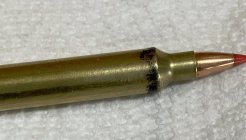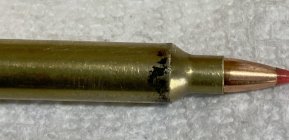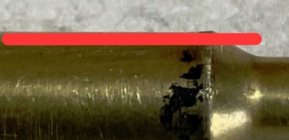A friend is having a problem with chambering some rounds that have been full length sized and reloaded. It appears that when the shoulder is being bumped back that the body of the brass is getting crushed at the shoulder/body junction. In the two photos you will see where the brass was marked with a marking pen. That brass was then honed to reveal the high and low spots. Relevant known details are:
Cartridge: 204 Ruger
Die: RCBS
Brass: Remington. The problem does not happen with Winchester brass.
The bullets are flat based and the bottom of the bullet is set at about the neck/shoulder junction. There is no donut getting pushed to the outside that I could detect. It looks like the crush expansion was causing the difficult chambering.
In comparing shoulder bump, most of the sized brass is 1-2 thousands shorter than the fired brass (1-2 thou bump that is). On these that have the crush, there does not appear to be any shoulder bump. They measure the same as the fired brass.
The only thing that comes to mind is that the die shoulder/body junction has a wider diameter than the chamber and the brass is weak at the point.
Anyone ever run into this? If so, were you able to determine the cause?
-

load.jpg
144 KB
· Views: 135
-

load1.jpg
124.8 KB
· Views: 137
Is there an expander ball in the FL sizing die ? Did you try removing the expander ball and sizing it?
On these that have the crush, there does not appear to be any shoulder bump. They measure the same as the fired brass
That sounds like the brass is harder than a prostitutes heart. Annealing will help that.
I've seen this when the brass is long and it hits the taper crimp in the seating die before the bullet has been fully seated.
Check the case lengths and adjust the die.
A friend is having a problem with chambering some rounds that have been full length sized and reloaded. It appears that when the shoulder is being bumped back that the body of the brass is getting crushed at the shoulder/body junction. In the two photos you will see where the brass was marked with a marking pen. That brass was then honed to reveal the high and low spots. Relevant known details are:
Cartridge: 204 Ruger
Die: RCBS
Brass: Remington. The problem does not happen with Winchester brass.
The bullets are flat based and the bottom of the bullet is set at about the neck/shoulder junction. There is no donut getting pushed to the outside that I could detect. It looks like the crush expansion was causing the difficult chambering.
In comparing shoulder bump, most of the sized brass is 1-2 thousands shorter than the fired brass (1-2 thou bump that is). On these that have the crush, there does not appear to be any shoulder bump. They measure the same as the fired brass.
The only thing that comes to mind is that the die shoulder/body junction has a wider diameter than the chamber and the brass is weak at the point.
Anyone ever run into this? If so, were you able to determine the cause?
Don't have a clue. Is the base of the bullet pushing against a donut inside the neck. I am not used to seeing bullets seated that deep. How far are the bullets from touch. The bullet base must be at the donut location???
Is there an expander ball in the FL sizing die ? Did you try removing the expander ball and sizing it?
I think so. I'm going to see if he can pull it and size again.
That sounds like the brass is harder than a prostitutes heart. Annealing will help that.

I think it is newer brass.
I've seen this when the brass is long and it hits the taper crimp in the seating die before the bullet has been fully seated.
Check the case lengths and adjust the die.
That sounds plausible. I'll check to see if the seating die taper crimps.
Don't have a clue. Is the base of the bullet pushing against a donut inside the neck. I am not used to seeing bullets seated that deep. How far are the bullets from touch. The bullet base must be at the donut location???
I checked both loaded and fired brass. I don't see a donut. It is usually visible if seating a bullet pushes it to the outside.
I've seen this when the brass is long and it hits the taper crimp in the seating die before the bullet has been fully seated.
Check the case lengths and adjust the die.
Why would you be using a crimping die?
Why would you be using a crimping die?
Lots of basic seating dies have an optional crimp. Raise the die crimp portion above the end of the neck for no crimp or lower it to get it to crimp where you want it. When crimping it's a bit of a balancing act adjusting the crimp and the seating stem to get everything where you want it. As he said it's easy to crush a case if it's not adjusted properly.
Lots of basic seating dies have an optional crimp. Raise the die crimp portion above the end of the neck for no crimp or lower it to get it to crimp where you want it. When crimping it's a bit of a balancing act adjusting the crimp and the seating stem to get everything where you want it. As he said it's easy to crush a case if it's not adjusted properly.
We see this problem as CJ6 mentioned come up on here a few times every year nearly.

See at what stage this is happening. I guessing in seating somehow without the fl die for support.
Tom
does the brass need the shoulder bumped back to start with? raise the FL dies a bit and see if it still happens. I dont think i ever needed to bump the shoulder back on a hunting rifle as the chambers are quite generous.
Have had it happen to me. The seating die is not adjusted correctly. The seating die needs to be turned out a couple revolutions and then readjust the seating stem for correct seating depth. The rounds that are collapsed as shown in the photos can be salvaged by removing the decapping stem from the sizing die, lubed and resize the affected rounds.
I had this happen with some soft Hornady 250AI brass but no to this extent. I replaced the brass with Lapua and all was fine. In this case it could also be the crimp ring. IIRC these are called banana cases
Have had it happen to me. The seating die is not adjusted correctly. The seating die needs to be turned out a couple revolutions and then readjust the seating stem for correct seating depth. The rounds that are collapsed as shown in the photos can be salvaged by removing the decapping stem from the sizing die, lubed and resize the affected rounds.
The brass and other components can certainly be salvaged, but the above appears to suggest sizing a loaded round. Not a good idea.
Sizing a loaded round is a good way to get it stuck in the sizing die, if it doesn’t stick, you end up with an under sized bullet that won’t shoot worth a spit.
I had a friend (who had been reloading for a lot of years), insisting his seating die indexed off the shoulder of the case. While I could see the advantage of that, I couldn't see how that would work. Turns out he was adjusting his seating depth by screwing the entire die further in, and running out of free space for the cartridge to occupy. End result was exactly what was shown in OP's post. Tom's suggestion is the first step in figuring out what the case is. Step by step and see where it's occurring. The solution should be obvious after that.
Seating does that crimp, work off of neck diameter first, then length. Most instructions setting up the die are vague at best, completely wrong at worst.
Basically run the die down until contact with the case neck, then a little bit farther to get the crimp. Some it’s use a loaded round to establish contact point.
The problem is the crimp works by basically running the case neck into a funnel, the farther into the funnel you bush the case, the tighter the crimp.
If you set the die touching sized brass, a 30 caliber case will contact where the .330” diameter case mouth touches the die. Once you seat the bullet, the neck diameter is now .334” and then is squeezed down to .330” with the ram all the way down.
This over crimping only gets worse with any case that is either longer or thicker than the one used to set the die. This is why using a seating die to crimp becomes very inconsistent. It’s not much better using a separate crimp die, it at least eliminates crushing shoulder because you’re not trying to seat a bullet deeper while at the same time adding more crimp and holding the bullet in place with the neck.m
Solution as other have said, back off the die so the crimp function is disabled.
I think so. I'm going to see if he can pull it and size again.
As the case comes up in the die near the end of the stroke can you feel abnormal increased effort indicating the effort to move the shoulder/body juncture? Only a couple things can cause this problem. Has to be a force pushing downward on the shoulder area. Easy to see which one.
1. Sizing
2. Seating the bullet
3. Crimping.













